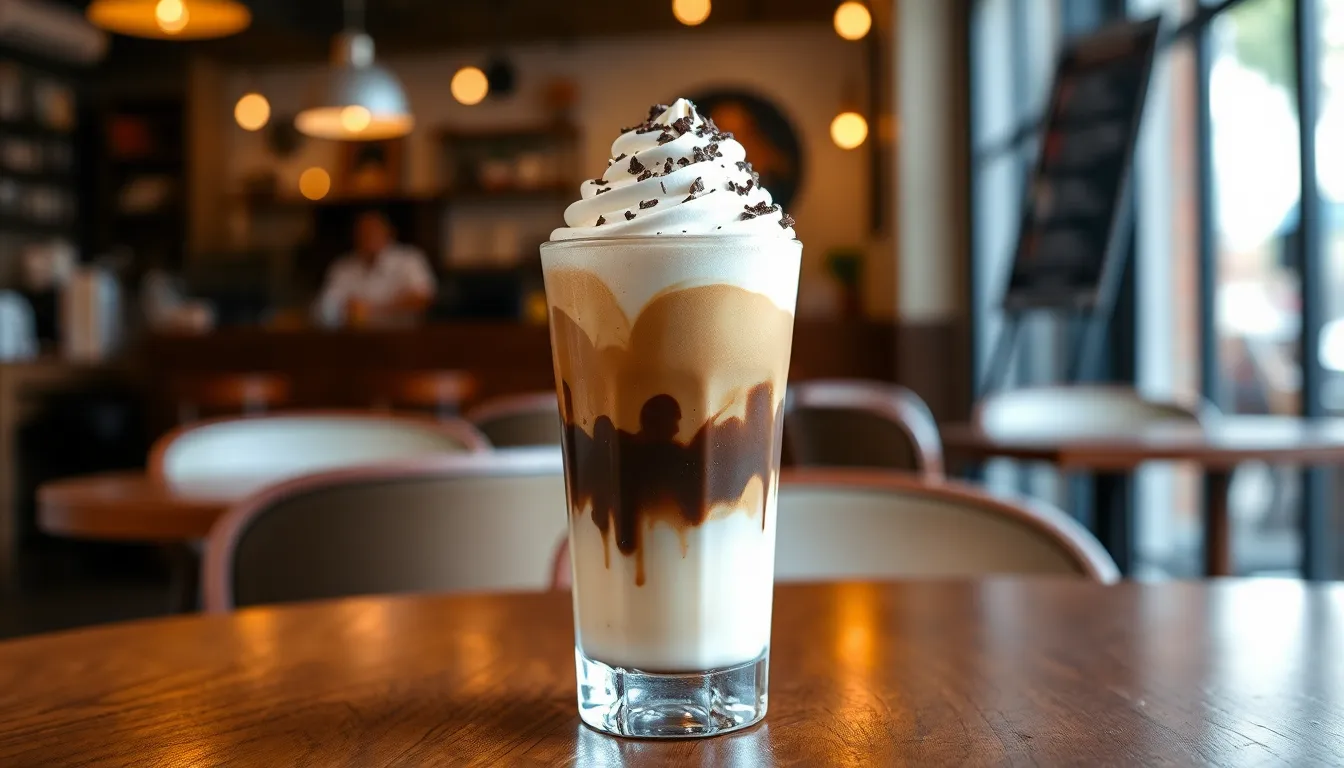Is mochaccino coffee? You’ve probably spotted this decadent-sounding drink on coffee shop menus and wondered about its true identity. Whether you’re a casual coffee drinker or a dedicated aficionado, understanding what makes a mochaccino special will enhance your next café visit.
A mochaccino blends the rich worlds of coffee and chocolate in one delightful cup. It’s essentially an espresso-based beverage that combines chocolate (usually chocolate syrup or cocoa powder), steamed milk, and often topped with whipped cream and chocolate shavings. While technically part of the coffee family, a mochaccino offers a sweeter, more dessert-like experience than your standard cup of joe.
What Is a Mochaccino: An Elegant Coffee and Chocolate Fusion
A mochaccino represents the perfect marriage between robust espresso and rich chocolate, creating an indulgent beverage that satisfies both coffee and chocolate cravings simultaneously. This specialty drink features a foundation of quality espresso, complemented by chocolate syrup or powder, and topped with steamed milk and foam. Many cafés enhance their mochaccinos with a decadent dollop of whipped cream and a dusting of chocolate shavings for an extra touch of luxury.
Unlike regular coffee, a mochaccino offers a more dessert-like experience with its balanced sweetness and smooth texture. The name “mochaccino” originates from combining “mocha” (referring to the chocolate component) and “cappuccino” (the espresso-based drink with steamed milk and foam). This linguistic blend perfectly reflects the harmonious fusion of flavors in the cup.
“I’ll never forget my first sip of a properly made mochaccino at a small café in Seattle,” shares Rikki Manny. “The way the chocolate melted into the espresso created this velvety texture that was completely different from my usual black coffee. It converted me instantly.”
Coffee enthusiasts appreciate how a mochaccino maintains the integrity of the espresso while introducing complementary chocolate notes. The drink typically contains 2-3 ounces of espresso, 1-2 ounces of chocolate, and 3-4 ounces of steamed milk, creating the ideal ratio for a balanced flavor profile. This composition places the mochaccino firmly in the coffee category while offering a more accessible entry point for those who find straight espresso too intense.
The Origins of Mochaccino and Its Rise to Popularity
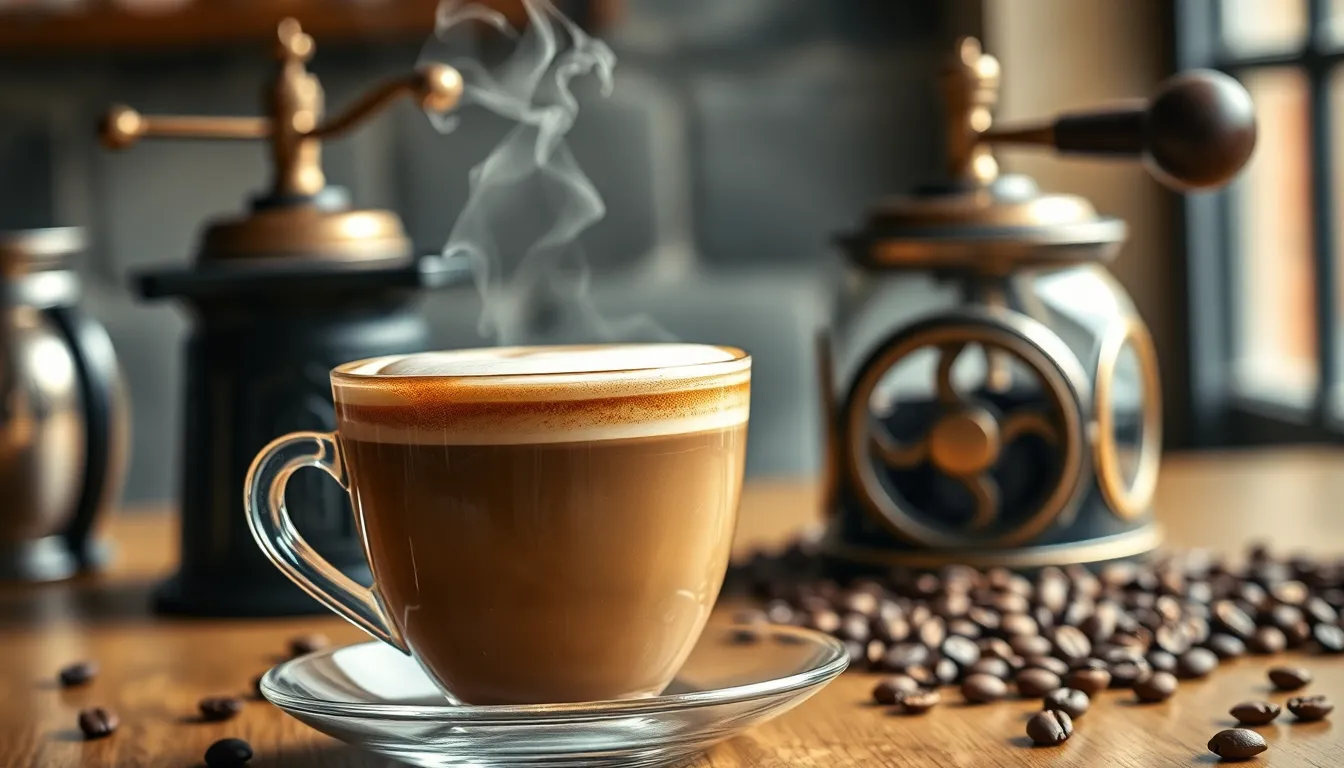
The mochaccino’s story begins in Yemen’s port city of Mocha (Al-Makha), a crucial coffee trading center from the 15th to 18th centuries. Though coffee plants didn’t grow in Mocha itself, the city served as the primary shipping point for beans harvested in Yemen’s mountainous regions. These Mocha beans developed a reputation for their distinctive chocolate undertones, which later inspired the naming of the chocolate-coffee fusion we enjoy today.
Italian coffee culture played a pivotal role in developing the modern mochaccino. In 18th-century Turin, a precursor called the “bavaresia” gained popularity at the renowned Caffè al Bicerin. Their signature creation, the “bicerin,” presented coffee, chocolate, and cream in elegant layers within small glasses. Patrons originally received these components separately and mixed them according to personal preference—an early form of coffee customization that foreshadowed today’s specialized coffee culture.
The transformation into what you’d recognize as a caffè mocha occurred in the United States during the late 19th century. The first documented recipe using the term “caffè mocha” appeared in 1892. American coffee entrepreneurs adapted the Italian bicerin by fully blending the ingredients rather than preserving the distinct layers, creating a more accessible and uniform beverage.
The mochaccino represents a fascinating blend of global coffee traditions—from Yemen’s historic beans with natural chocolate notes to Italian artisanal craftsmanship and American innovation. This rich heritage explains why the mochaccino continues to captivate coffee enthusiasts seeking something beyond ordinary coffee but more sophisticated than purely sweet drinks. Its balanced profile of bitter coffee, rich chocolate, and creamy milk makes it an enduring favorite in coffeehouses worldwide.
Mochaccino vs. Mocha: Understanding the Difference

Mochaccino and mocha both offer delightful chocolate-coffee experiences, but they differ significantly in several key aspects. Mochaccino delivers a balanced blend of coffee and chocolate with a milder chocolate presence, creating a harmonious taste experience that doesn’t overpower the espresso flavor. The drink combines elements of both mocha and cappuccino, resulting in a unique coffee beverage that satisfies multiple cravings simultaneously.
The chocolate intensity marks the most notable difference between these two popular drinks. Mochaccino incorporates cocoa powder or a light chocolate syrup that complements rather than dominates the coffee taste. Mocha, in contrast, features a strong chocolatey flavor, typically from generous amounts of chocolate syrup that creates a more dessert-like profile.
Texture variations also distinguish these two beverages from one another. Mochaccinos offer a thinner, latte-like consistency that feels lighter on the palate. Mochas provide a thicker, more indulgent mouthfeel that resembles a dessert drink more than a traditional coffee beverage.
The presentation style differs distinctly between the two drinks:
| Feature | Mochaccino | Mocha |
|---|---|---|
| Chocolate Flavor | Mild, balanced with coffee | Strong chocolatey profile |
| Coffee Base | Espresso with steamed milk and chocolate | Espresso with heated milk and chocolate |
| Texture | Thinner, similar to a latte | Thicker consistency |
| Toppings | Usually cocoa powder or light chocolate syrup | Often whipped cream with chocolate garnishes |
| Origin | Modern fusion of mocha and cappuccino | Originated from Yemen’s Al Makha port |
| Serving Style | Similar to cappuccino with chocolate accent | Served in glass with chocolate inside and on top |
Preparation methods highlight further differences between these coffee varieties. Baristas create mochaccinos by combining espresso, steamed milk, and a modest amount of cocoa powder or chocolate syrup, finishing with a light cocoa sprinkle. The mocha preparation involves pouring chocolate syrup at the base, adding espresso and steamed milk, then crowning with whipped cream and chocolate garnishes.
The origin stories of these drinks add another layer of distinction. Mochaccino represents a modern invention that fuses traditional elements from both mocha and cappuccino traditions. Mocha traces its heritage back to the Yemeni port city of Al Makha, a important historical coffee trading center known for beans with natural chocolate undertones.
These differences make each drink appeal to distinct preferences. Mochaccino attracts those seeking a coffee-forward experience with chocolate accents, while mocha satisfies cravings for a richer, more chocolate-dominant indulgence that borders on dessert territory.
Key Ingredients That Make a Perfect Mochaccino
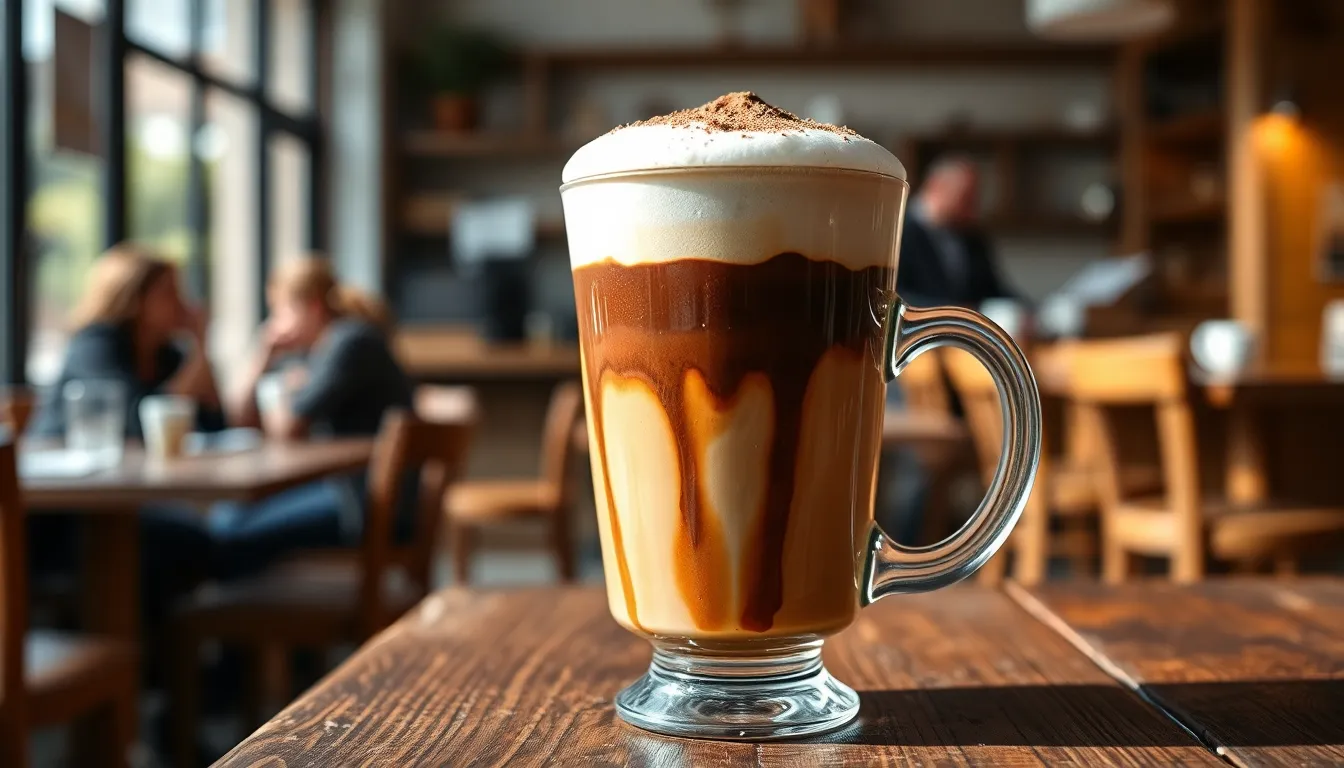
A mochaccino’s distinctive character comes from its carefully balanced blend of three essential components: espresso, chocolate, and milk. Each ingredient plays a crucial role in creating that perfect harmony of flavors that makes this beverage so beloved.
The Coffee Base: Espresso Essentials
Espresso forms the foundation of any authentic mochaccino, providing that bold, rich coffee flavor that coffee enthusiasts crave. Traditional recipes call for two shots (approximately 2 oz) of freshly pulled espresso to establish a strong coffee presence. The concentrated nature of espresso ensures it doesn’t get lost among the other ingredients, particularly the chocolate. Some cafés offer brewed coffee as a milder alternative, but purists maintain that espresso delivers the intensity and authenticity that defines a true mochaccino experience.
The Chocolate Component: Types and Proportions
Chocolate balances the espresso’s intensity while adding sweetness and complexity to your mochaccino. Several chocolate forms work effectively in this drink:
- Chocolate syrup provides sweetness and mixes easily into the espresso
- Cocoa powder offers a richer, less sweet chocolate profile
- Chocolate shavings add textural interest and enhance flavor complexity
The ideal ratio follows a simple formula: one part espresso to one part chocolate syrup (or cocoa), combined with two parts steamed milk. High-quality chocolate makes a noticeable difference in the final taste. Many coffee shops experiment with different chocolate varieties, sometimes combining white, milk, and dark chocolates to create signature flavor profiles. The chocolate amount can be adjusted based on personal preference—some enjoy a stronger chocolate presence while others prefer the coffee flavor to dominate.
Milk and Foam: Creating the Signature Texture
Steamed milk constitutes the largest volume component of a mochaccino, typically about 4 oz in a standard recipe. The milk provides essential creaminess that softens the robust coffee-chocolate combination. A defining characteristic of the mochaccino is its foam layer on top—a feature inherited from its cappuccino heritage. This foam adds lightness and textural contrast to each sip, balancing the drink’s overall richness. Whole milk creates the most luxurious mouthfeel, though any milk variety works based on dietary preferences. The quality of the foam depends on proper steaming technique, with baristas often creating microfoam that integrates perfectly with the espresso-chocolate mixture below.
The harmonious blend of these three elements—strong espresso, quality chocolate, and perfectly steamed milk with foam—creates the distinctive flavor profile that makes a mochaccino both satisfying and sophisticated.
How to Make a Barista-Quality Mochaccino at Home
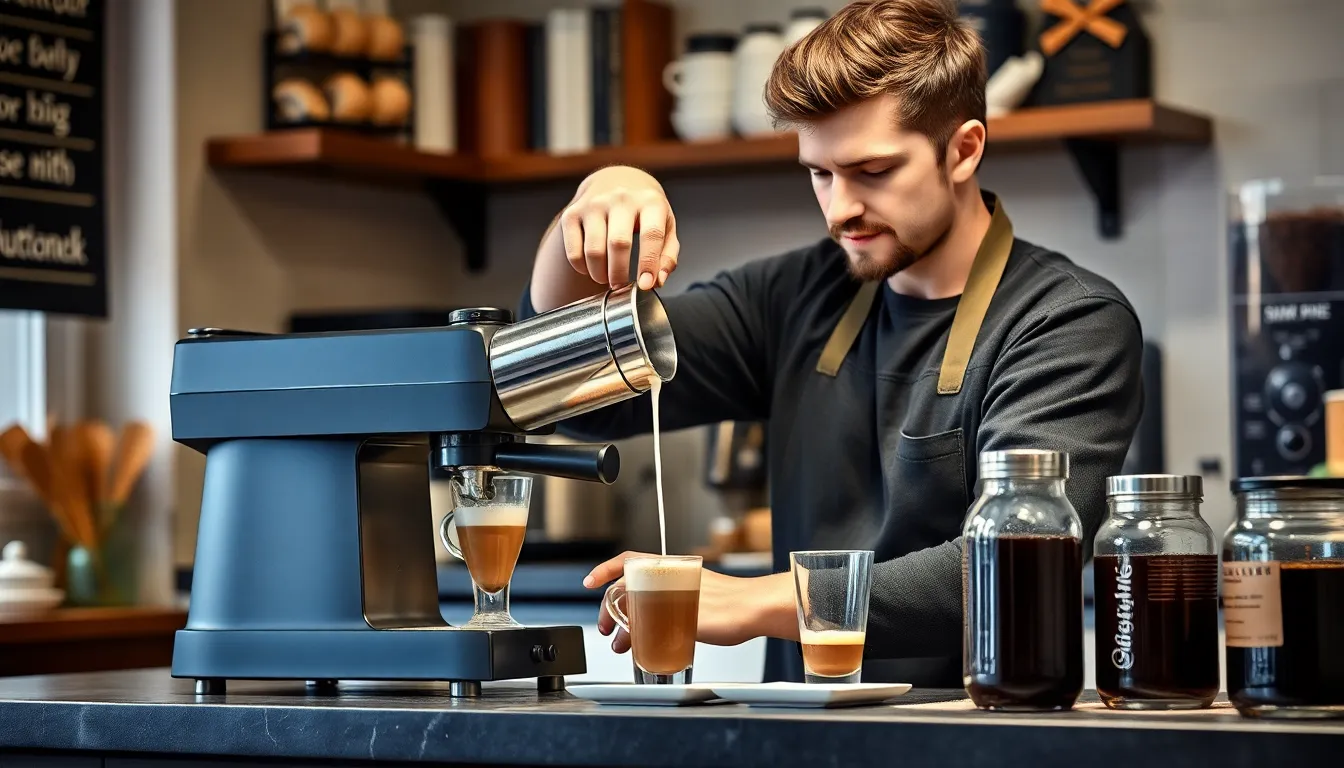
Creating a café-worthy mochaccino at home requires just a few key tools and ingredients. You’ll discover that crafting this chocolate-espresso delight is simpler than it appears, allowing you to enjoy the perfect balance of rich flavors without leaving your kitchen.
Essential Equipment for the Perfect Home Mochaccino
An espresso machine or stovetop espresso maker serves as the foundation for your homemade mochaccino. You’ll also need a milk steamer or alternative frothing method, such as shaking heated milk in a jar for that signature foamy texture. A tall glass showcases the beautiful layers of your creation, while a spoon helps with proper mixing and foam placement. These basic tools transform ordinary ingredients into a barista-level experience that rivals your favorite coffee shop.
Ingredients
For a perfect mochaccino, gather:
- 1 ounce finely ground coffee beans
- 2 ounces water for brewing espresso
- 4 ounces milk (any variety works)
- 2 ounces chocolate syrup (or cocoa powder/chocolate shavings)
The quality of each ingredient directly impacts your final beverage. Fresh coffee beans produce a more aromatic espresso, while your choice of chocolate affects the overall sweetness and depth of flavor.
Step-by-Step Brewing Guide
- Brew two shots (approximately 2 ounces) of espresso using your preferred method.
- Steam 4 ounces of milk until it’s hot and frothy. If you don’t have a steam wand, heat the milk on the stove and create foam by vigorously shaking it in a sealed jar or whisking it.
- Mix the freshly brewed espresso with 2 ounces of chocolate syrup in your serving glass. Chocolate syrup offers convenience and sweetness, though cocoa powder or chocolate shavings provide a richer, less sweet alternative.
- Pour your steamed milk carefully over the espresso-chocolate mixture, allowing the flavors to blend naturally.
- Spoon the milk foam onto the top, creating that distinctive creamy layer that defines a proper mochaccino.
- Add optional garnishes like a dusting of cocoa powder, a sprinkle of chocolate chips, or an artistic drizzle of chocolate syrup for visual appeal and extra flavor.
The espresso base delivers the bold coffee notes essential to an authentic mochaccino, while your chocolate selection determines the beverage’s character. Different milk varieties produce varying textures of foam, with whole milk typically yielding the creamiest results. This meticulous layering technique ensures each sip contains the perfect harmony of coffee intensity, chocolate richness, and milk creaminess that makes a mochaccino so irresistibly satisfying.
Popular Mochaccino Variations Around the World
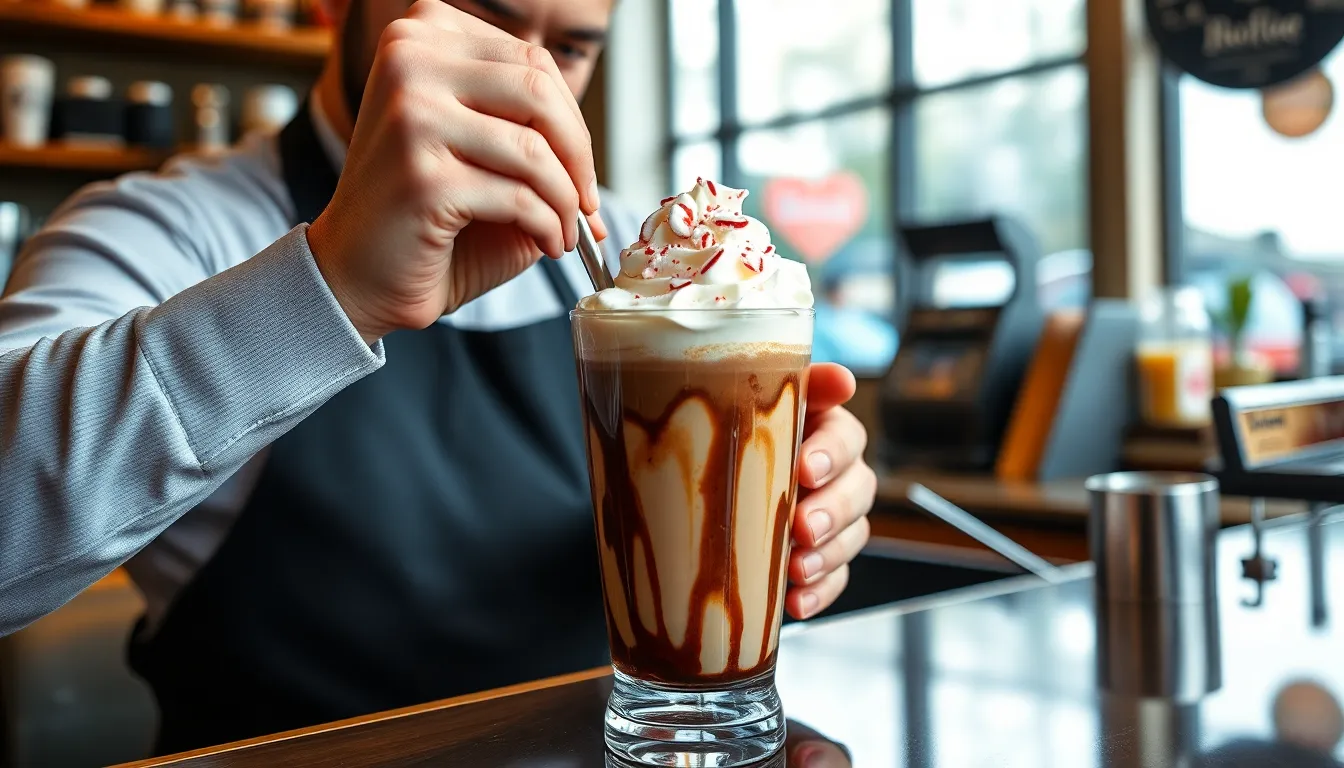
Mochaccino’s versatility has inspired baristas and coffee enthusiasts to create many innovative variations that elevate the classic chocolate-coffee combination. Creative twists on the traditional recipe incorporate different flavors, spices, and toppings to suit diverse palates and preferences.
Peppermint Mocha delivers a refreshing twist with its invigorating mint-chocolate profile. This seasonal favorite combines espresso with peppermint syrup and chocolate sauce, topped with steamed milk, whipped cream, and crushed peppermint candy for a festive experience.
Caramel Mocha, sometimes called Sea Salt Caramel Mocha, enhances the traditional recipe with rich caramel syrup. A light sprinkle of sea salt balances the sweetness while creating a sophisticated flavor contrast that amplifies both the chocolate and caramel notes.
Mexican Spiced Mocha pays homage to traditional Mexican chocolate by incorporating warming spices like cinnamon and chili powder. These additions create a complex flavor profile with subtle heat that complements the rich chocolate undertones.
Triple Chocolate Mocha satisfies intense chocolate cravings by combining dark, milk, and white chocolate varieties. This decadent creation offers a deeply layered chocolate experience that coffee shops often promote as their premium offering.
Coconut and Hazelnut variations introduce nutty and tropical dimensions to the classic mochaccino. These flavor additions create distinctive taste profiles that transport you to different culinary landscapes while maintaining the drink’s comforting essence.
Mochaccino enjoys particular popularity in Bangladesh, Hong Kong, Japan, Mauritius, New Zealand, and Vietnam. Coffee enthusiasts in these countries appreciate the harmonious balance between sweet chocolate and robust coffee flavors, making it a versatile option for any time of day.
Health Considerations: Calories and Nutritional Profile
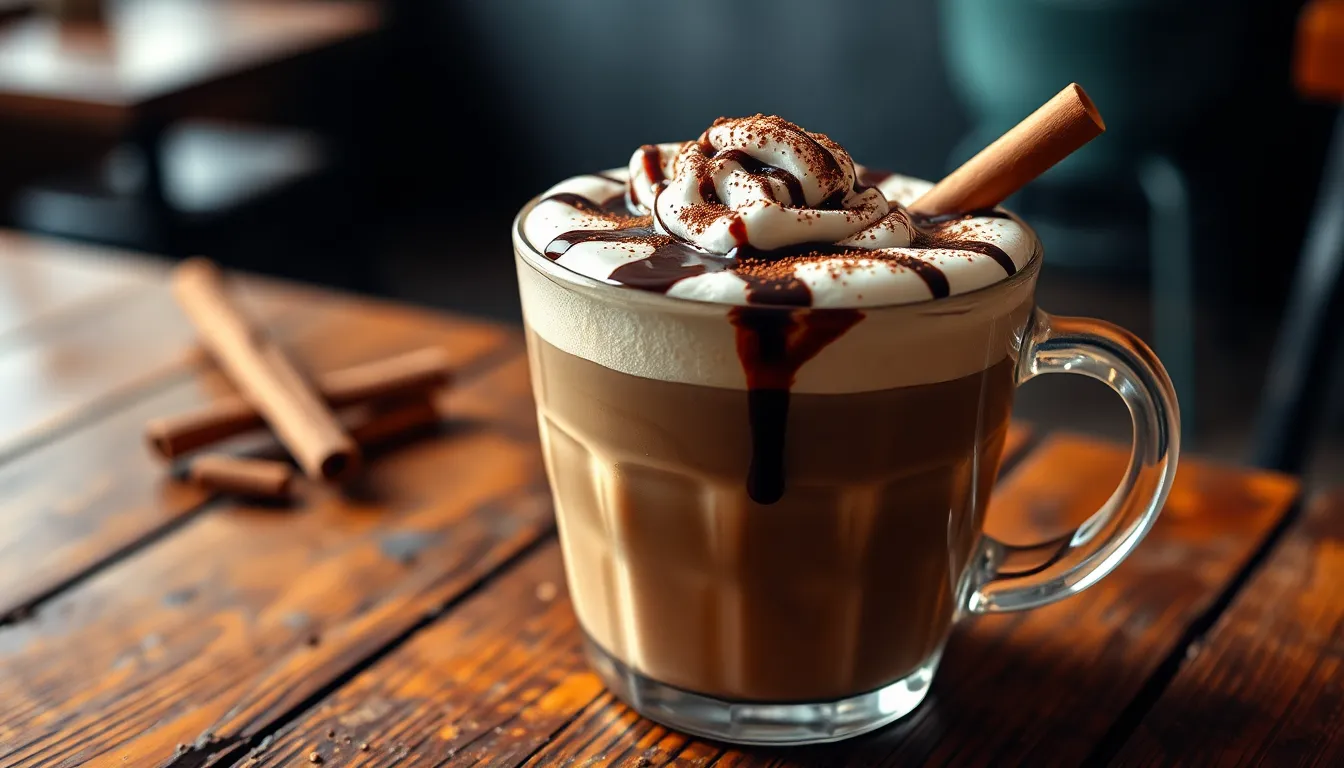
Mochaccino’s nutritional profile varies dramatically depending on serving size, ingredients, and preparation methods. A typical Society Coffee mochaccino contains just 78 calories, comprised of 14g carbohydrates, 2.2g fat, and 1g protein. Illy’s canned version offers a slightly higher calorie count at 100 calories, with its macronutrient distribution being 77% carbohydrates, 8% fat, and 15% protein.
Larger mochaccino servings can significantly increase caloric intake. A 240g cup provides approximately 290 calories, containing 12g fat, 8g protein, and 35g carbohydrates according to SnapCalorie data. Those seeking lighter options might prefer Maud’s mochaccino mocha at only 60 calories per serving, with 12g carbs and 1.5g fat.
Carbohydrate content in mochaccinos comes primarily from chocolate syrup and milk sugars. Some commercial versions contain up to 30g of sugar per serving, an important consideration for those monitoring their sugar consumption. Fat content fluctuates based on milk choice, with whole milk or cream-based versions containing up to 7g of saturated fat per serving.
Protein levels in mochaccinos depend largely on milk content, with dairy-based versions providing up to 8g per serving. Beyond macronutrients, these coffee drinks can deliver beneficial micronutrients including calcium (up to 300mg or 23% daily value) and potassium (up to 400mg). Certain mochaccino products even contain vitamin D fortification, sometimes reaching 500% of the recommended daily value.
Your milk selection dramatically impacts the overall nutritional profile. Opting for plant-based alternatives like almond or oat milk creates a lower-calorie beverage, while using whole milk produces a richer, more caloric drink. Customizing your chocolate syrup amount allows direct control over sugar content, making mochaccinos adaptable to different dietary preferences while still delivering their characteristic chocolate-coffee flavor.
Conclusion
The mochaccino stands as a perfect bridge between coffee tradition and modern indulgence. This exquisite blend delivers the complexity coffee enthusiasts crave while offering enough sweetness to welcome those new to espresso drinks.
Whether you’re sipping a classic version or exploring global variations the mochaccino offers endless opportunities for customization. You’ll find it adapts beautifully to your taste preferences and dietary needs while maintaining its distinctive character.
Next time you’re looking for something beyond your regular coffee but not quite as dessert-like as a full mocha try ordering or creating a mochaccino. It’s that perfect middle ground that celebrates the best of both coffee and chocolate worlds in one elegant cup.
Frequently Asked Questions
What is a mochaccino?
A mochaccino is a specialty coffee drink that combines espresso, chocolate, and steamed milk, typically topped with milk foam and sometimes whipped cream and chocolate shavings. It offers a balanced blend of coffee intensity and chocolate sweetness, making it a more approachable option for those who find straight espresso too strong while still delivering a sophisticated coffee experience.
How is a mochaccino different from a mocha?
While both contain espresso and chocolate, mochaccinos feature a milder chocolate presence with a lighter, latte-like texture. Mochas have a stronger chocolate flavor and thicker, more dessert-like consistency. Mochaccinos use a modest amount of cocoa powder or chocolate syrup, while mochas typically incorporate generous amounts of chocolate and are often topped with whipped cream.
What are the origins of the mochaccino?
The mochaccino traces its roots to Yemen’s port city of Mocha, famous for coffee beans with chocolate undertones. It was influenced by Italian coffee culture, particularly the 18th-century “bavaresia” from Turin that combined coffee, chocolate, and cream. The modern version evolved in the United States in the late 19th century, blending these ingredients into the uniform beverage we enjoy today.
What ingredients make a perfect mochaccino?
A perfect mochaccino requires three key ingredients in proper balance: quality espresso (providing bold flavor), chocolate (as syrup, cocoa powder, or shavings for sweetness and complexity), and steamed milk (for creaminess topped with foam). The ideal ratio is one part espresso to one part chocolate and two parts milk. This harmonious blend creates the distinctive flavor profile that makes mochaccinos so satisfying.
Can I make a mochaccino at home?
Yes! You’ll need an espresso machine or stovetop maker, milk steamer, and a tall glass. Use finely ground coffee, water, milk, and chocolate syrup or cocoa powder. Focus on quality ingredients and proper technique—especially the layering of espresso, chocolate, and milk—to achieve the perfect balance of flavors and textures. With practice, you can create a café-worthy mochaccino in your own kitchen.
What popular variations of mochaccino exist?
Popular variations include Peppermint Mocha (with mint-chocolate profile), Caramel Mocha (with caramel syrup and sea salt), Mexican Spiced Mocha (featuring cinnamon and chili powder), Triple Chocolate Mocha, and Coconut and Hazelnut versions. The drink is particularly popular in Bangladesh, Hong Kong, Japan, Mauritius, New Zealand, and Vietnam, where coffee enthusiasts appreciate its versatility and balanced flavors.
How many calories are in a mochaccino?
A typical mochaccino contains between 60-290 calories, depending on serving size and ingredients. Calorie and fat content varies based on milk choice (whole, skim, plant-based), while sugar levels depend on the amount of chocolate syrup used. While mochaccinos provide beneficial micronutrients like calcium and potassium, be mindful that commercial versions may contain high sugar levels. The drink can be customized to suit various dietary preferences.

